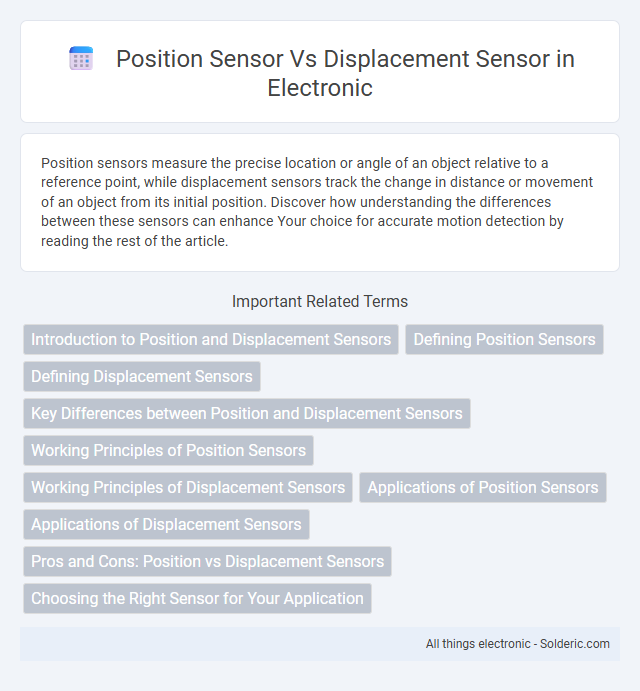Position sensors measure the precise location or angle of an object relative to a reference point, while displacement sensors track the change in distance or movement of an object from its initial position. Discover how understanding the differences between these sensors can enhance Your choice for accurate motion detection by reading the rest of the article.
Comparison Table
| Aspect | Position Sensor | Displacement Sensor |
|---|---|---|
| Definition | Measures the absolute location of an object in a reference frame. | Measures the change in position or movement from an initial point. |
| Measurement Type | Absolute position | Relative movement or displacement |
| Output | Coordinates or absolute position value | Distance moved or change in position value |
| Common Types | Encoders, GPS, LVDT | LVDT, potentiometers, laser displacement sensors |
| Typical Applications | Robotics, navigation, machine tool positioning | Vibration monitoring, material testing, automation |
| Accuracy | High accuracy for absolute location | High resolution for small movements |
Introduction to Position and Displacement Sensors
Position sensors measure the specific location of an object along one or more axes and provide precise coordinate data, essential for robotics and automation. Displacement sensors quantify the change in position or distance from a reference point, often used in applications like material testing and structural monitoring. Both sensor types enhance control systems by delivering accurate spatial information, but position sensors focus on absolute location while displacement sensors emphasize relative movement.
Defining Position Sensors
Position sensors determine the precise location of an object along a specific axis or within a defined space, converting physical movement into measurable electrical signals. Unlike general displacement sensors that measure the overall change in distance or movement between two points, position sensors provide exact coordinate data critical for applications requiring accurate positioning control. Common types include linear potentiometers, capacitive sensors, and optical encoders, all essential in robotics, manufacturing automation, and aerospace navigation systems.
Defining Displacement Sensors
Displacement sensors measure the change in position of an object relative to a reference point, providing precise data on linear or angular movement. Unlike position sensors, which determine an object's absolute location in space, displacement sensors focus on detecting variations in distance or angle over time. Common types include potentiometric, inductive, capacitive, and optical displacement sensors, each optimized for specific accuracy and application requirements.
Key Differences between Position and Displacement Sensors
Position sensors measure the absolute location of an object relative to a reference point, while displacement sensors quantify the change in position as an object moves from an initial point. Position sensors provide static spatial data, essential for applications requiring precise object placement, whereas displacement sensors deliver dynamic information about motion or distance traveled. Common technologies for position sensing include potentiometers and encoders, whereas displacement sensing often uses LVDTs and laser sensors for high-resolution movement detection.
Working Principles of Position Sensors
Position sensors operate by detecting the precise location or angular displacement of an object through various mechanisms such as capacitive, inductive, or optical methods. Displacement sensors specifically measure the change in position relative to a reference point, often using linear variable differential transformers (LVDTs), potentiometers, or laser triangulation. Understanding their working principles helps you select the appropriate sensor for applications requiring accurate measurement of movement or position changes.
Working Principles of Displacement Sensors
Displacement sensors measure the change in position of an object by detecting its linear or angular movement, often using methods like capacitive, inductive, or optical sensing to convert physical displacement into an electrical signal. Position sensors determine the exact location of an object, focusing on absolute position rather than relative change, typically utilizing technologies such as potentiometric or magnetic sensors. Your choice between displacement and position sensors depends on whether you need to track movement over time or pinpoint a fixed location within a defined range.
Applications of Position Sensors
Position sensors are widely used in robotics for precise control of robotic arms and automated machinery, enhancing accuracy in manufacturing processes. They play a crucial role in automotive systems, such as throttle position sensing and gear shift detection, to improve vehicle performance and safety. In aerospace, position sensors ensure accurate control surface movements and landing gear positioning, critical for flight stability and safety.
Applications of Displacement Sensors
Displacement sensors are widely utilized in industrial automation to monitor and control precise movements in machinery, ensuring accurate positioning in manufacturing processes. They are essential in automotive systems for measuring suspension travel and throttle position, enhancing vehicle performance and safety. In aerospace, displacement sensors help track critical component movements, contributing to reliable and efficient aircraft operation.
Pros and Cons: Position vs Displacement Sensors
Position sensors offer precise measurement of an object's exact location within a defined range, making them ideal for applications requiring accurate angular or linear position feedback. Displacement sensors excel in detecting the amount of movement or change in position, often providing higher resolution for small-scale shifts, but may lack absolute position reference. Your choice depends on whether absolute position tracking or relative movement monitoring is more critical for your system's performance and control.
Choosing the Right Sensor for Your Application
Selecting the right sensor between a position sensor and a displacement sensor depends on the specific measurement needs of your application, such as whether absolute or relative motion tracking is required. Position sensors provide precise location data within a defined range, ideal for robotics and automation systems, while displacement sensors measure changes in distance or movement, suitable for monitoring vibrations or deflections. Understanding factors like resolution, range, response time, and environmental conditions ensures optimal sensor performance and accurate data collection.
position sensor vs displacement sensor Infographic

 solderic.com
solderic.com